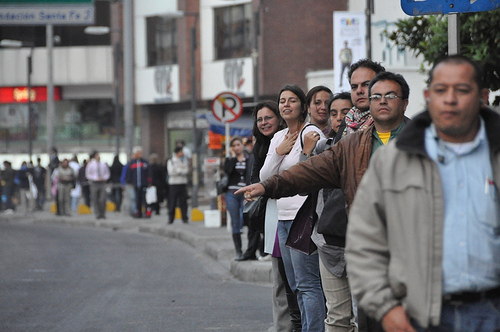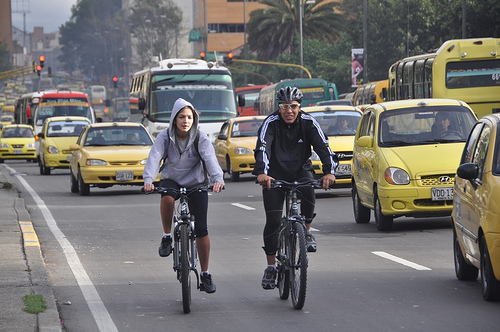
Car-Free Day Bogotá 2010. Photo by Carlos Felipe Pardo, Flickr carlosfpardo, used under a CC BY 2.0 license
On February 3, the city of Bogotá held a Car-Free Day –a day when restrictions are placed on the circulation of private vehicles. The day is designed as a strategy to raise environmental awareness and improve, for one day, vehicular traffic in cities worldwide.
Sysmaya shared [es] information from the radio station RadioSantafe [es] with its readers:
Un balance positivo del día sin carro ó del día del aire limpio entregó el alcalde Mayor de Bogotá, Samuel Moreno Rojas, quien reportó una sustancial reducción de la contaminación ambiental con la salida de circulación de 1 millón 430 mil vehículos particulares.
En los trece puntos de control a las emisiones de las fuentes fijas, revisaron un total de 526 vehículos de los cuales 551 no pasaron las pruebas atmosféricas y 80 automotores fueron inmovilizados.
A positive review of the car-free day or clean air day was presented by the Mayor of Bogota, Samuel Moreno Rojas, who reported a substantial reduction of air pollution from the absense of 1 million 430 thousand vehicles from circulation.
In the thirteen emission control points, a total of 526 vehicles were reviewed, of which 551 failed the atmospheric tests and 80 vehicles were immobilized.
On Twitter, the hashtag #Diasincarro (car-free day) documented opinions on the different situations that arose during the day. The reduction of carbon monoxide levels was highlighted as one of the positive outcomes of the day:
Mejor en bici (better in a bike) (@mejorenbici) reported:
44 por ciento bajó el monóxido de carbono en el #diasincarro Muchas gracias BOGOTA y feliz fin de semana.
Carito Camargo (@Caritoesoterica) wrote about how peaceful it was to move around the city:
Excelente este #diasincarro nada mejor que desplazarse por la ciudad con tranquilidad….ademas llegue por fin a las 6 a la U bien bien
Lina Gutiérrez (@ChefGuty) noticed a decrease in noise levels:
Mi #diasincarro paso sin pena ni gloria….no sentí la diferencia del trancón pero si en el ruido me hizo feliz el silencio.

Car-Free Day Bogotá 2010. Photo by Carlos Felipe Pardo, Flickr carlosfpardo, used under a CC BY 2.0 license
For some, like Robert Salazar (@SoySalazarR), there were no major differences and even reported traffic congestion:
la 10 con el #diasincarro es peor!! no crei que fuera a poder decir esto algun dia. La decima puede empeorar
Lina Hurtado (@linhure) tweeted about the difficulties in using public transportation and in getting from one place to another:
Esto sonará anticívico de nuevo, pero me molesta ver que son las 10:30pm y mucha gente aun no puede llegar a casa por culpa del #Diasincarro
Felipe Gutiérrez (@PiPe_DaRk) and Alfonso Penagos (@AlfonsoPenagos) think there was no major environmental impact with the measure. In that order, they wrote:
creo que el #diasincarro funciona mas para los taxistas que para el medio ambiente…seguimos respirando humo.
Bueno creo que el balance del #díasincarro es un completo fracaso… ni siquiera el medio ambiente se vio favorecido.
I think that the #carfreeday is better for cab drivers than for the environment…we are still breathing smog
Well I think that the outcome of the #carfreeday is a complete failure… not even the environment was favored
However, others think the car-free day should be implemented in other places and with greater frequency. Christina Méndez (@ImChrizM), for example, said:
El #diasincarro fue lo máximo, debería ser con más frecuencia.
David Olaya (@DavidOlaya) added:
Debería haber mas de un #diasincarro al año, no solo en #Bogota sino en otras ciudades.
With a similar view, Yenny Moreno (@chela_moreno) wrote:
#diasincarro una de las mejores formas para cuidar el planeta, lastima que no sea tan frecuente.
Finally, Sebastián Movilla (@sebasmovilla) shares his satisfaction with the day's results linking to the Colombian newspaper El tiempo, which wrote the headline: “Speed increased and pollution decreased in the car-free day,” where it reviews what happened during the day:
Muy satisfactorios los resultados de este #diasincarro en #Bogota, deberia hacerse muchas veces mas al año http://bit.ly/eIQG0w #mejorenbici
You can read more about this initiative in a previous post published by Global Voices when this same day was held in the city of Medellín.






